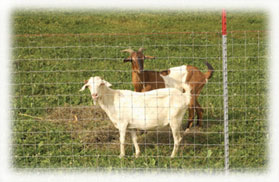
GOAT HEALTH CARE: **UNDER CONTRUCTION**
Probably the most effective and efficient method of identifying a goat that is sick or in need of medical treatment is the human eye. If your goat is not eating well, standing off by itself, acting differently than it typically does, then something is probably wrong. If you notice this, then act quickly to identify the problem. Goats are sturdy, but not indestructible. They frequently dont show many signs or symptoms at the early stages of illness, so by the time you see something is wrong, the situation has already progressed significantly. Signs of a healthy goat include:
Attitude - Alert and curious
Appetite - Shows interest in food. Chews cud after feeding
Breathing - Regular and unlabored
Coat/Skin - Clean, glossy and no lumps
Droppings Pellets are firm
Eyes - Bright, clear and not running
Gait - Steady with no limping
Nose - Cool and dry
Weight - Average weight and gain, check loin for body condition.
(5) FEEDING, NUTRITION & BRUSH GOATS
(7) BUCK MANAGEMENT & ARTIFICIAL INSEMINATION
(8) GOAT GENETICS, WILD GOATS & PYGMY GOATS
An older doe seem to be able to postpone or accelerate the birth of their kids to take advantage of good weather. A good kidding day is a mild and humid day, with a minimum of wind; kids and lambs are best born in a Scotch Mist, where loss of heat by evaporation of the birth fluids is at a minimum. The first kidding day which comes within a fortnight of when the kids are due (GESTRATION 146-156 days) is the normal choice of an experienced mother. Most goats will choose a place under the cover of trees or rock sheltered from showers, crows and gulls.
The ruminant animal has a rumen, reticulum, omasum, and abomasum; the simple-stomached animal has a stomach. The newborn ruminant functions as a simple-stomached animal. At birth, the rumen is small and nonfunctional. When the kid nurses, a band of muscle tissue (the esophageal groove) closes to form a direct tubular connection from the esophagus to the abomasum.
If you bottle feed kids, it is important to hold the kid in a natural nursing position so the esophageal groove closes properly. If milk is put into the rumen, either by tube-feeding or improper bottle-feeding, a considerable time may elapse before the milk makes it to the abomasum and can be digested for use. Milk may also curdle in the rumen and cause some colic symptoms.
If the kid wags its tail and butts its muzzle when feeding, this is a sign that the esophageal grove mechanism is in operation and milk is entering the abomasum (true stomach).
An increasingly popular method of dead animal disposal is COMPOSTING. Under this system, goat carcasses are placed in a bin containing sawdust or another source of carbon, thus creating an ideal environment for the growth of bacteria. Bacterial action rapidly heats compost piles to temperatures as high as 160 F and within several weeks carcasses are reduced, leaving only brittle bones, which are easily crumbled. Turning the compost pile by moving it to a new bin (secondary bin) after two weeks helps maintain high temperatures and speeds up the composting process.
All who drink of this remedy are cured,
except those who die.
Thus, it is effective for all but the incurable.
---Galen---

|
Woody Guthrie said: "So long, it's been good to know you."
